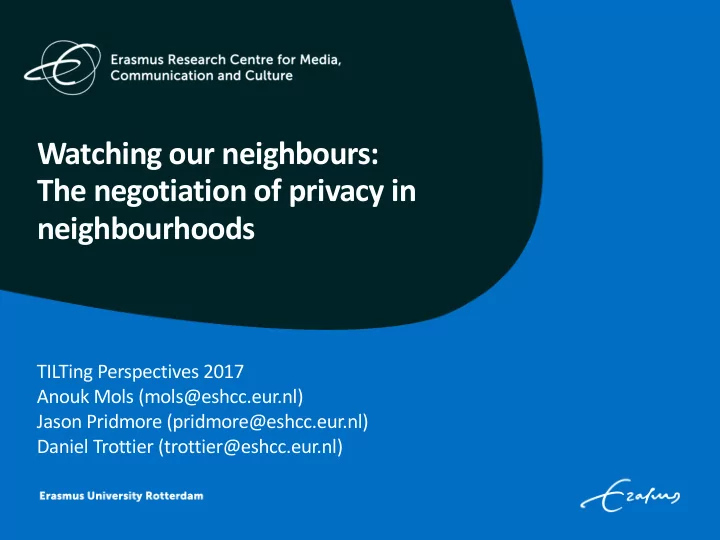

Watching our neighbours: The negotiation of privacy in neighbourhoods TILTing Perspectives 2017 Anouk Mols (mols@eshcc.eur.nl) Jason Pridmore (pridmore@eshcc.eur.nl) Daniel Trottier (trottier@eshcc.eur.nl)
“Often, I walk around the neighbourhood once or twice a week, because it is healthy, but also because I am the group moderator. I just make a round. And then you’ll see that I kind of check what’s going on. People keep their curtains open at night, which is special, but you’ll directly see if the right people are on the couch or not .” (Marc, moderator)
WhatsApp Neighbourhood Watch WhatsApp Buurtpreventie • Recently emerged phenomenon • Neighbourhood WhatsApp groups to prevent break-ins • Supplement and supplant ‘physical’ neighbourhood watch groups • 6943 NL-based groups registered on www.wabp.nl (May 15, 2017 ) Existing public reports (grey literature) address benefits & pitfalls + Decreased break-ins Tilburg (Akkermans & Vollaard, 2015) + Low participation threshold (Bervoets, 2014) + Increased social cohesion (Van der Land et al., 2014) – Stereotyping & racist behaviour (Lub, 2016) – Increased feelings of unsafety (Lub, 2016) – Privacy issues members (De Vries, 2016)
Critical concerns • Intersection of several concepts in current literature • Blurring of boundaries • Personal/Professional; Public/Private; Immediacy/Remoteness • Context collapse (Marwick & boyd, 2011) • Lateral surveillance (Andrejevic, 2007) • Monitoring your neighbourhood defaults to monitoring neighbours • Skeptical and savvy participants co-constructing safety • Participatory policing (Reeves, 2017; Larsson 2017) • “If you see something, say something” • Limited actual police involvement, citizen mobilisation
Providing a multidimensional understanding Sample: 14 WhatsApp neighbourhood watch groups, differing in: • Size • Level of professionalisation • Involvement of third parties (police, municipality, etc.) • Neighbourhoods: Degree of urbanity Method • 14 In-depth interviews with group moderators • 2 Focus groups with group members • Audio-recorded, transcribed • Constructive grounded theory analysis (inspired by Charmaz 2014) • Inductive qualitative content analysis (using Atlas.ti )
Neighbourhood safety Feeling safe • “I believe that it also provides sort of a sense of security ” (Kai, moderator) Feeling anxious • Chrissy: “Sometimes I experience it creates unrest .” Lucia: “Yes, I understand that remark, because at a certain point, you become nervous.” Interviewer: “So how do you feel when you receive a WNW group message?” Lucia: “Well, if it is as close by as last time...” Vera: “Yes, that was really close.” Lucia: “Yes, then I am really terrified . And then, I always sleep with the windows open, we sleep at ground floor level with the windows open, well, then I close the windows.” (members during focus group discussion)
Monitoring the neighbourhood • “Everyone knows at what time everyone goes to work” (Klara, moderator) • “When there are cars in the neighbourhood we’re not familiar with , or we are not sure about people we have never seen before , we’ll make a picture and send it : ‘Do we know anything about this?’” (Pauline, moderator) • “We’ve had a situation with a dark skinned man at the [name of street] who was reported [in the WNW group], and everyone went out to look for him . Even though someone reported: ‘the police is informed’, they started searching for him anyway.” (Emma, member)
Private space Own neighbourhood • “It is not always pleasant, because it really can feel as if you are being watched, and to what extent is that good? (…) Sometimes you will keep a bit of a distance , they are your neighbours, but you do not have to be running in and out all the time” (Pauline, moderator) Other neighbourhoods • “I am well aware that nowadays, (...) you will give rise to suspicion when you’re in a neighbourhood where you don’t belong or where you are not familiar .” (Lars, member) • “ I would not like that [being photographed], I think that nobody would like that, why is a complete stranger taking a picture of me?” (Bert, moderator)
Personal information • Commercial nature of WhatsApp • Administrative and screening practices of moderators • Privacy of passer-by’s and visitors • Visibility of phone numbers • “I needed a phone number, or I needed a person, and then I thought: Oh, he is probably part of the group , so I called him, and he didn’t even asked where I got his number.” (Lars, member)
Tensions and conflicts Purposes of the group • “There are also members, and this is where it goes wrong , who will post things like: ‘Hey Harry, how is the weather?’. There are these ignorant people who do not get the purpose of this [WNW group]. And we will tell them: ‘Please, only use this for emergency situations ’” (Kai, moderator) Misidentification (ethnic profiling, wrongful accusations, and misplaced distrust) • “Someone said: ‘There was a suspicious car , the door was open for a long time, but they were chatting, and when I looked in their direction, they immediately left’. And then a girl reacted angrily: ‘What the hell! That was my boyfriend and we were chatting. Why is he suspected? Because he is Turkish? ’ That sort of things happen, you know.” (Saskia, moderator)
Preliminary conclusions • WhatsApp neighbourhood watch Increasingly popular phenomenon • Ambivalent nature & precarious consequences • Policy considerations • Contextual integrity
Thank you for listening! Anouk Mols (mols@eshcc.eur.nl) Jason Pridmore (pridmore@eshcc.eur.nl) Daniel Trottier (trottier@eshcc.eur.nl) Mapping Privacy and Surveillance Dynamics in Emerging Mobile Ecosystems project NWO Privacy Research in Cyber Environment grant (PRICE) NSF Early Concept Grants for Exploratory Research (EAGER)
Recommend
More recommend